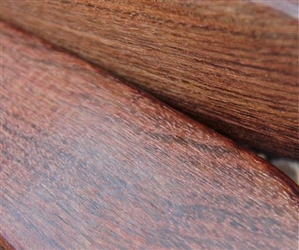 |
Chechem
Chechem (pronounced "chay-CHEM") is a hard, dense wood from Mexico, Central America and the British West Indies with an unusually moderate specific gravity that produces a surprisingly lower tone than you might expect.
Chechem (aka Black Poison Wood) is very hard and dense and resistant to wear. It is often used as a substitute for Brazilian rosewood. The bark of the tree secretes a caustic sap that can cause a painful rash like poison ivy.
Bone Rattling Facts
Chechen is a popular choice for snare drums. It is also well suited for hand-held musical instruments because Chechen is very durable, slightly oily, and resistant to rot and insect attack. The wood is not harmful to you. Only the sap and sanding dust are toxic. So you can safely rattle bones made of Chechen with no ill effects. Then again, you can add this wood to your collection just to prove that you live dangerously."
Cool Facts
-
Chechen is part of the Anacardeiaeae family, which includes cashews, pistachios, mangoes, poison oak, poison ivy, and poison sumac.
- It is a preferred material for railroad ties.
- It's alternate name is black poisonwood from the toxic sap that turns black and causes severe skin reactions. Wiki reports that "The Mayans still tell stories of poisoning the water supplies of Yucatecan soldiers with chechen during the Guerra de las Castas in the mid-1800s."
Figures below are approximate (but pretty darn close)
Tonality
Can't Decide Which Bones to Choose?
Check out this handy guide: Bone FAQs
Scroll down for technical Chechem facts...
|
|
Chechem Facts
Scientific Name
Metopium brownei (aka: Metopium browneii, Amyris toxifera, Metopium linnaei, Metopium toxiferum)
Other Names
Chechem is known by at least 36 common names.
Black poison
Black poisonwood
Boarwood
Bois mulatre
Boxcheche
Bumwood
Burn wood
Caribbean Rosewood
Cedro prieto
Chachin
Chechem negro
Chechen
Cochinilla
Cochinillo
Coral sumach
Cotinillo
Doctor gum
Florida poisontree
Guao
Guao de costa
Guao de peadero
Hog doctor
Hog gum
Hog plum
Honduras walnut
Jamaica sumach
Kabal'chechem
Manceniller
Mountain manchineel
Mulatre
Palo de rosa
Papayo
Papyo
Poison tree
Poison wood
Poisontree
Lookalike Woods
The color varies widely enough that Chechem is often substituted for these three other woods.
Teak
Rosewood
Black Walnut
Grain
The grain displays a fine texture and small pores. It is usually straight but can vary with wild and wavy interlocking patterns.
Texture
Texture is typically fine and uniform. The wood is slightly oily and yields a fine finish.
Luster
The wood displays a warm golden luster.
Heartwood Color
Streaked brown
(Banana Fudge Ripple)
The heartwood is dark reddish brown with dark brown stripes and lighter streaks. The color is somewhat similar to Black walnut, although the color can vary widely.
Sapwood Color
The sapwood is yellowish brown and clearly distinct from the heartwood.
Aroma
There is no characteristic odor, smell or taste.
Woodworking
The wood is safe to handle. But don't inhale the sanding dust which can cause dermatitis and respiratory issues. Chechem is an easy wood to work, although interlocking grain can cause problems when planing or surfacing. Nails and screws should be pre-drilled because this very dense wood tends to split. Glues and finishes well.
Environmental Profile
Chechem is available from environmentally responsible or sustainably managed sources. The Nature Conservancy reports that "Although the species may be quite rare in parts of its range, especially at the periphery, it is reported to be rather abundant, and secure globally." The lesser-known species, Black Poisonwood, is a possible substitute for some of the more exotic and endangered species.
Distribution
The species is reported to occur in Central America, Latin America, North America, Oceania and S.E. Asia.
Tree Data
Chechem grows to the size of a shrub or a fairly tall tree reaching a height of about 50 feet (15 m) with a trunk diameter of about 21 inches (50 cm).
|
|
|